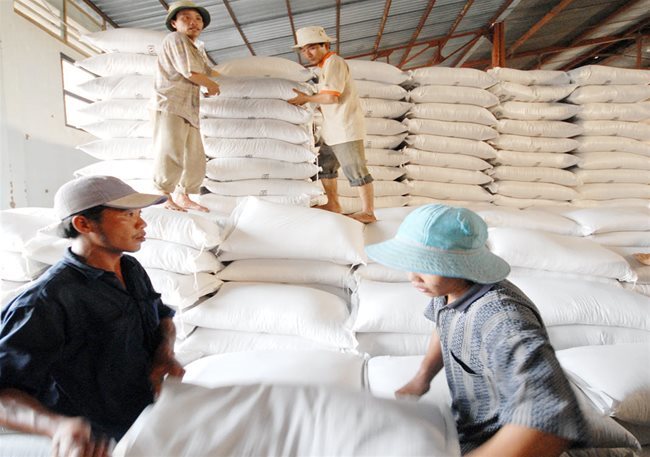 |
| Rice stored in a warehouse in the Mekong Delta - PHOTO: LE HOANG VU |
Despite considerable efforts to promote exports in the first half of this year, statistics and estimates by economic managers show that though the total volume of agro-product exports reached 6.79 million tons, an increase of 281,000 tons, or 4.3%, from the year-earlier period, the total export turnover of 13 key agro-, forestry and fisheries products was only US$17.6 billion, down 2.3% year-on-year. This contradiction signifies a deep plunge in the prices of agro-products, which cannot be offset by an increase in export volume.
In this context, rice exports are really a rare highlight, with an export volume of 3.54 million tons, up only 5.6% year-on-year, but an export value of nearly US$1.73 billion, up 19.4%.
Remarkably, this positive result owes largely to the export performance in May, shortly after the abolition of rice export quota control. May rice exports reached 954,000 tons, a record high in Vietnam’s rice export history. This volume is 1.84 times higher than the average exports of the five other months, while its price is US$516 per ton, 8.2% higher than the average export price in the period.
These figures reveal two things. First, the quota for 800,000 tons of rice exports in April and May set by the Ministry of Industry and Trade is much below the actual exports of 1.46 million tons, and the argument that the export of all three million tons of rice from the winter-spring crop will pose a risk for national food security is not true to reality.
Second, the arguments of opponents to the quota control, such as no restriction will not cause rice shortage and restriction means missing out the opportunity of export at a high price, may be justified. True, after the strict quota control was abolished, the rice export volume surged in May. However, the good performance could not be maintained, as exports in June plunged as much as less than half of the May volume and 24.7% from the year-earlier period, while the export price dropped.
Challenges ahead
The strong decline in the rice export volume and the fall in the export price in June are the first signs for the end of the period of favorable rice exports and good export prices. Challenges over the coming months will grow bigger.
First, there is a confluence of factors which will increase significantly the competitiveness of Indian rice, putting the Asian rice export community in a difficult position, and Vietnam is no exception.
According to recent information from India, India is expecting “twin” records in rice and wheat yields thanks to abundant water in the rainy season this year and the Government’s increase of the buying prices for rice and wheat from the current crops. Furthermore, the storage volumes of these two staple foods are expected to reach record highs this year. In addition, developments in the global financial market make the rice export price lower in terms of the U.S. dollar.
These are the reasons for the wide gap in the offers of Indian rice and the Asian rice, especially the Thai rice. They also explain why the volume of rice India has won in the recent tender in the Philippines is half as much again as that of Vietnam, while Thailand lost in the tender. The Philippines, however, later abolished the tender, citing that the domestic rice supply was secure.
Meanwhile, another source of information said Malaysia had overcame many hurdles to reach agreement for an import order for 100,000 tons of Indian rice in May, double the average annual volume of Indian rice imported into the country over the past five years.
All that information shows that with its outstanding competitiveness, India has continued to outperform even in markets where Vietnam has gained the strongest competitiveness over the past many years.
Further, statistics of Vietnam show that the Middle East and Africa are important markets which have contributed to Vietnam’s rice export achievements, with their share of the country’s rice exports over the past five months increasing to 18.3% versus 12-14% over the past five years. Apparently, with her capacity to overcome Vietnam in Southeast Asia, seen as the country’s “home ground” rice market, it is highly likely that India could win over Vietnam in Africa, as this is its “home ground” market.
Considering such strong competitiveness while aiming for repeating the record export volume of 11 million tons of rice in the current crop, two million tons higher than exports in the last crop, India is apparently the strongest rival of Vietnam in the coming months.
Second, Thailand, albeit currently the underdog to Vietnam, will try every way to increase its competitiveness, thus causing greater pressure for Vietnam’s rice exports in the coming months. Drought which has caused losses for Thailand’s off-season rice crop has ended. The country may see an increase in the rice yield from the current main crop thanks to more rains, so it can definitely improve its rice export performance in the coming months against the strong decline in the early months of the year. Obviously, to increase its market share, Thailand must reduce its rice price to narrow the wide gap with those of rivals.
Consequently, Thailand will cause greater competition pressure to Vietnam’s rice exports in the coming months.
For Vietnam, that seems to be too excited by the good crop and good price enjoyed over the past months, her plan to increase the rice farming area and productivity in the upcoming time may put the country in a difficult position in the competition for rice export markets.
In sum, in the context of the projected decline in the global rice import demand while the world’s largest and second largest rice exporters, which account for about half of the global rice export market, are ramping up competition for market shares after many months of sluggishness, Vietnam will certainly face greater competition pressure in rice exports in the coming months. SGT
Nguyen Dinh Bich

Will technical barriers imposed by the Philippines create difficulties for Vietnam’s rice exports?
It will be difficult for Vietnamese businesses to keep stable rice exports to the Philippines in large quantities as currently seen, experts said.

Vietnam likely to export 6.7 million tonnes of rice this year
Vietnam is likely to reach its rice export target of 6.7 million tonnes this year thanks to favourable market conditions and high global demand, according to the Ministry of Agriculture and Rural Development.